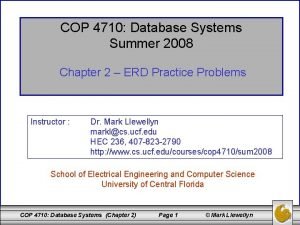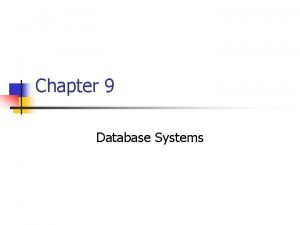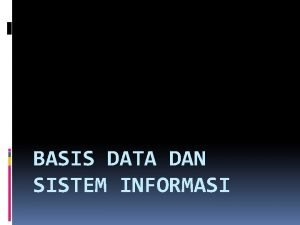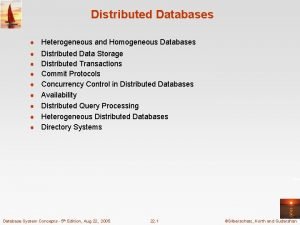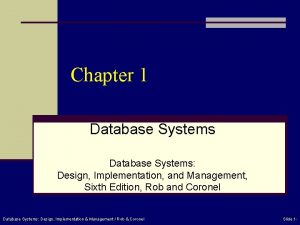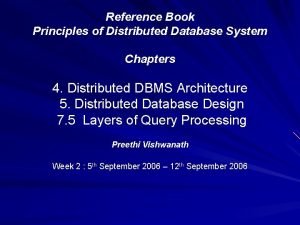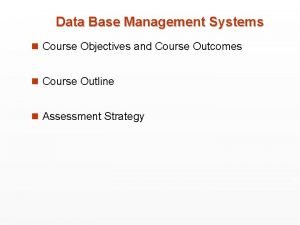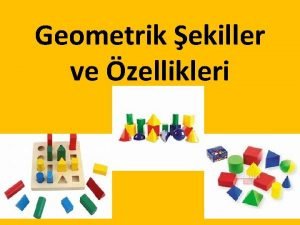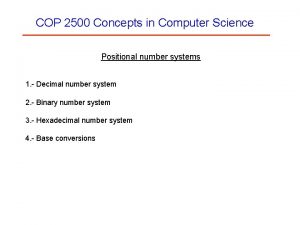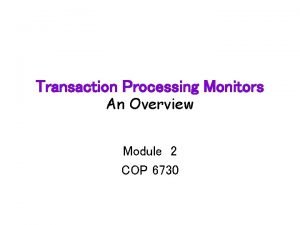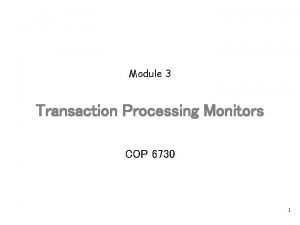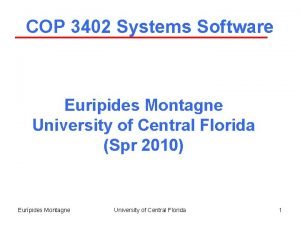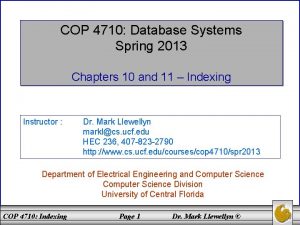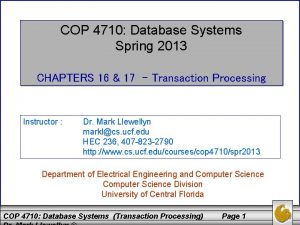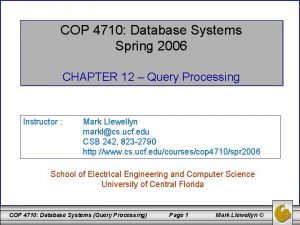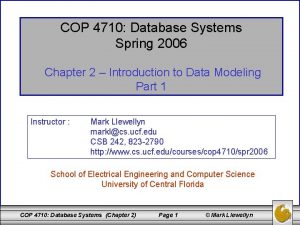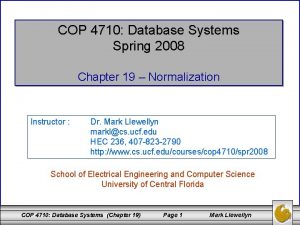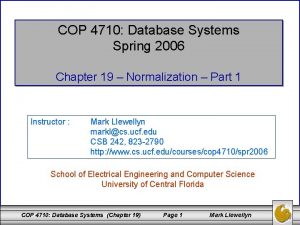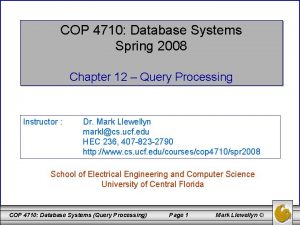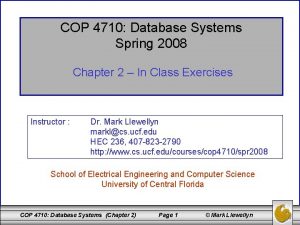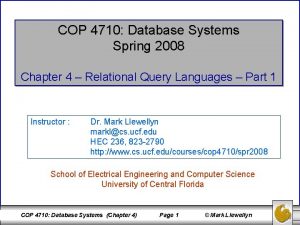COP 4710 Database Systems Spring 2013 Chapter 3

COP 4710: Database Systems Spring 2013 Chapter 3 – Logical Data Modeling And The Relational Data Model Instructor : Dr. Mark Llewellyn markl@cs. ucf. edu HEC 236, 407 -823 -2790 http: //www. cs. ucf. edu/courses/cop 4710/spr 2013 Department of Electrical Engineering and Computer Science Division University of Central Florida COP 4710: Database Systems (Chapter 3) Page 1 © Dr. Mark

The Relational Data Model • The relational data model is based on the concept of mathematical relations. • Codd (the guy who proposed the relational model) was a trained mathematician and he used terminology taken from this discipline, primarily set theory and predicate logic. COP 4710: Database Systems (Chapter 3) Page 2 © Dr. Mark

The Relational Data Model (cont. ) • Relation: A relation is a table (matrix) with rows and columns. Relations hold information about the objects modeled in the db. • Attribute: An attribute is a named column of a relation. An attribute is some characteristic of an entity (or relationship) that is modeled in the database. Attributes can appear in any order in a relation. • Domain: A domain is the set of allowable values for one or more attributes. Every attribute is defined on some domain. Domains may be distinct for each attribute, or two or more attributes may be defined on the same domain. COP 4710: Database Systems (Chapter 3) Page 3 © Dr. Mark

The Relational Data Model (cont. ) • Tuple: A tuple is a row of a relation. Tuples can appear in any order in a relation and the relation will remain the same, and therefore convey the same meaning. • Degree: The degree of a relation is the number of attributes it contains. • Cardinality: The cardinality of a relation is the number of tuples it contains. • Relational database: A collection of normalized relations with distinct relation names. COP 4710: Database Systems (Chapter 3) Page 4 © Dr. Mark

An Example Relation attributes cardinality staff relation staff. No f. Name l. Name position DOB salary sn 24 Kristy Chivotti manager 1 -Oct-64 45000 sa 3 Tod Spaude ceo 16 -Nov-56 90000 sn 69 Debi Alonzo cfo 14 -Mar-72 67000 sf 22 Michael Schumacher driver 3 -Jun-77 9999999 sd 8 Keri Thompson manager 5 -Jun-78 34000 sx 99 Julie Bledsoe manager 16 -Dec-63 40000 degree COP 4710: Database Systems (Chapter 3) Page 5 © Dr. Mark

Example Domain Definitions Attribute Domain Name Meaning Domain Definition staff. No staffnumbers set of all possible staff numbers character: size 4, must begin with letter s. f. Name, l. Name name set of all possible person names character: size 20 DOB date person was born date: range from 1 -Jan-20, format: dd-mmm-yy salaries possible values of staff salaries monetary: 7 digits, range 10, 0009, 999 set of all possible positions select one from set: {ceo, cfo, coo, manager, asst. manager, driver, secretary} position alljobs COP 4710: Database Systems (Chapter 3) Page 6 © Dr. Mark

Alternate Terminology for Relational Model Formal Term Alternative 1 Alternative 2 relation table file tuple row record attribute column field COP 4710: Database Systems (Chapter 3) Page 7 © Dr. Mark

What is a Relation • To understand the true meaning of the term relation, we need to review some basic math concepts: • Given two sets D 1 and D 2 where D 1 = {2, 4} and D 2 = {1, 3, 5} • The Cartesian product of these two sets, written D 1 D 2, is the set of all ordered pairs such that the first element is a member of D 1 and the second element is a member of D 2. – D 1 D 2 = {(2, 1), (2, 3), (2, 5), (4, 1), (4, 3), (4, 5)} • Any subset of this Cartesian product is a relation. – Thus, we could produce relation R such that: R = {(2, 3), (4, 3)} • We can specify some condition which will select elements from D 1 D 2 to be included in R, such as: – R = {(x, y) | x D 1, y D 2, and y = 3} COP 4710: Database Systems (Chapter 3) Page 8 © Dr. Mark

What is a Relation (cont. ) • Given three sets D 1, D 2, and D 3 where D 1 = {2, 4}, D 2 = {1, 3}, and D 3 = {3, 6} • The Cartesian product of three sets, written D 1 D 2 D 3 , is the set of all ordered triples such that the first element is a member of D 1, the second element is a member of D 2, and the third element is a member of D 3. – D 1 D 2 D 3 = {(2, 1, 3), (2, 1, 6), (2, 3, 3), (2, 3, 6) (4, 1, 3), (4, 1, 6), (4, 3, 3), (4, 3, 6)} • Any subset of this Cartesian product is a relation. • In general, if D 1, D 2, . . . Dn are n sets. Their Cartesian product is defined as: and generally written as: COP 4710: Database Systems (Chapter 3) Page 9 © Dr. Mark

What is a Relation (cont. ) • A relational schema is a named relation defined by a set of attribute and domain name pairs. – Ri = {A 1: d 1, A 2: d 2, . . . , An: dn | d 1 D 1, d 2 D 2, . . . , dn Dn} • A relational database schema is a set of relation schemas, each with a distinct name. – R = {R 1, R 2, . . . , Rn} COP 4710: Database Systems (Chapter 3) Page 10 © Dr. Mark

What is a Relation (cont. ) A relation has the following properties: 1. The relation has a name that is distinct from all other relation names in the relational schema. 2. Each cell (attribute) contains exactly one atomic value. 3. Each attribute has a distinct name. 4. The values of an attribute are all from the same domain. 5. Each tuple is distinct; there are no duplicate tuples. 6. The order of the attributes has no significance. 7. The order of the tuples has not significance, theoretically. (However, in practice, the order may affect the efficiency of accessing tuples. Much more on this later. ) COP 4710: Database Systems (Chapter 3) Page 11 © Dr. Mark

Relation Schemas vs. Relation Instances • There is an important distinction to be made between a relation schema and a relation instance. • The schema is the name and attributes for the relation and is relatively immutable. • An instance is a set of tuples for that relation, and the instance may change frequently. Indeed most updates and certainly every insert and deletion will change the instance. – A snapshot database models the current “state” of the real world which is captured in the database. At any given moment in time it is modeling the current “instance” of the real world. If the real world state changes, so too must the database to maintain the representation of the current real world instance. COP 4710: Database Systems (Chapter 3) Page 12 © Dr. Mark

Equivalent Relations A B C A 1 2 3 1 3 2 1 3 4 4 1 4 2 1 3 2 a relation instance A B C 4 4 1 3 2 1 3 1 2 4 3 2 1 3 A B C 4 4 1 3 2 1 1 2 2 1 a relation instance equivalent relation instances this relation instance is not equivalent to any of the other three COP 4710: Database Systems (Chapter 3) Page 13 a relation instance © Dr. Mark

Logical Design • During logical design you transform the conceptual design into relational database schemas. – • The inputs to the process are the E-R diagrams and the outputs are the relational schemas. Mapping the E-R diagrams to relations is a relatively straightforward process with a well-defined set of rules. In fact many CASE tools (Computer Aided Software Engineering tools) can automatically perform many of the conversion steps. However, it is important that you understand the steps in this process for three reasons: 1. CASE tools often cannot model more complex data relationships such as ternary relationships and superclass/subclass relationships. These steps will need to be done manually. 2. There are some legitimate alternatives where you must manually chose an alternative. 3. You need to be prepared to perform a quality check on the results obtained with the CASE tool. COP 4710: Database Systems (Chapter 3) Page 14 © Dr. Mark

Logical Design (cont. ) • In the steps that we’ll need to follow to map E-R diagrams into relational schemas, it will be helpful to remember that we’ve defined three basic types of entities which are summarized below: – Regular (strong) entities are entities that have an independent existence and generally represent real-world objects such as persons or products. Represented in ERDs by rectangles with a single line. – Weak entities are entities that cannot exist except with an identifying relationship with an owner (strong) entity type. Weak entities are identified by a rectangle with a double line. – Associative entities (also sometimes called gerunds) are formed from many-to-many relationships between other entity types. Associative entities are represented by a rectangle with a single line that enclosed the diamond relationship symbol. COP 4710: Database Systems (Chapter 3) Page 15 © Dr. Mark

Mapping E-R Diagrams to Relational Schemas STEP 1: Mapping Regular (Strong) Entities • Each regular entity in an ERD is transformed into a relation schema. • The name given to the relation is generally the same as the entity type. • Each simple attribute of the entity type becomes an attribute of the relation schema. • The identifier becomes the primary key of the corresponding relation. COP 4710: Database Systems (Chapter 3) Page 16 © Dr. Mark

Mapping E-R Diagrams to Relational Schemas (cont. ) STEP 1: Map Regular (Strong) Entities - EXAMPLE customer_id customer-name customer-address E-R diagram customer-id customer-name customer-address Customer relation COP 4710: Database Systems (Chapter 3) Page 17 © Dr. Mark

Mapping E-R Diagrams to Relational Schemas (cont. ) Composite Attributes: • When a regular entity type has a composite attribute, only the simple component attributes of the composite attribute are included in the new relation schema. customer_id customer-name customer-address (street, city, state, zip) E-R diagram customer-id customer-name street city state zip Customer relation COP 4710: Database Systems (Chapter 3) Page 18 © Dr. Mark

Mapping E-R Diagrams to Relational Schemas (cont. ) Multi-valued Attributes: • When a regular entity type contains a multi-valued attribute, two new relation schemas (rather than one) are created. • The first relation schema contains all of the attributes of the entity type except the multi-valued attribute. The second relation schema contains two attributes that form the primary key of the second relation schema. The first of these attributes is the primary key of the first relation schema, which becomes a foreign key in the second relation. The second is the multi-valued attribute. • The name of the second relation should capture the semantics of the multi-valued attribute. COP 4710: Database Systems (Chapter 3) Page 19 © Dr. Mark

Mapping E-R Diagrams to Relational Schemas (cont. ) Multi-valued Attributes Example: employee E-R diagram employee-id employee-name employee-address {skill} employee-id Resulting relation schemas employee-name employee-address Arrow represents a referential integrity constraint. In table employee-skill the attribute employee-id is a foreign key, i. e. , it is a primary key in another table. The arrow links the attribute to the table where it is the primary key. employee-skill employee-id COP 4710: Database Systems (Chapter 3) skill Page 20 © Dr. Mark

Mapping E-R Diagrams to Relational Schemas (cont. ) Multi-valued Attributes: • Notice in the previous relational schemas constructed due to the multi-valued attribute skill, that the resulting relation schema employee-skill has only key attributes. • Each tuple simply records the fact that a given employee possesses a certain skill. • This provides the database designer the opportunity to suggest to the users that new attributes can be added to this relation. – For example, the attributes years-experience and/or certification-date might be appropriate new values to add to this relation. COP 4710: Database Systems (Chapter 3) Page 21 © Dr. Mark

Mapping E-R Diagrams to Relational Schemas STEP 2: Mapping Weak Entities • Recall that a weak entity type does not have an independent existence, but exists only through an identifying relationship with another entity type called the owner. • A weak entity does not have a complete identifier, but must have an attribute called a partial identifier that permits distinguishing the various occurrences of the weak entity for each owner entity instance. • The following procedure assumes that you have already created a relation schema corresponding to the identifying entity type. If you have not done this – do it now before proceeding. COP 4710: Database Systems (Chapter 3) Page 22 © Dr. Mark

Mapping E-R Diagrams to Relational Schemas STEP 2: Mapping Weak Entities - continued • For each weak entity type, create a new relation schema and include all of the simple attributes (or simple components of composite attributes) as attributes of this relation schema. • Then include the primary key of the identifying relation as a foreign key attribute in this new relation schema. • The primary key of the new relation schema is the combination of this primary key of the identifying relation and the partial identifier of the weak entity type. COP 4710: Database Systems (Chapter 3) Page 23 © Dr. Mark

Mapping E-R Diagrams to Relational Schemas STEP 2: Mapping Weak Entities - EXAMPLE dependent employee E-R diagram dependent-name (first-name, middle-name, last-name) dob gender employee-id employee-name employee-id Resulting relation schemas employee-name dependent first-name middle-name last-name COP 4710: Database Systems (Chapter 3) Page 24 employee-id DOB gender © Dr. Mark

Mapping E-R Diagrams to Relational Schemas STEP 3: Mapping Binary Relationships • The procedure for mapping relationships into the relational model depends on both the degree of the relationship (unary, binary, ternary, etc. ) and the cardinalities of the relationships. • We’ll look at the most common and important of these over the next several pages. Note that binary 1: M and binary M: 1 relationships are symmetric. COP 4710: Database Systems (Chapter 3) Page 25 © Dr. Mark

Mapping E-R Diagrams to Relational Schemas STEP 3: Binary 1: M Relationships • For each binary 1: M relationship, first create a relation schema for each of the two entity types participating in the relationship using the procedure from Step 1. • Next, include the primary key attribute (or attributes) of the entity on the one-side of the relationship as a foreign key in the relation that is on the many-side of the relationship. (The primary key migrates to the manyside. ) COP 4710: Database Systems (Chapter 3) Page 26 © Dr. Mark

Mapping E-R Diagrams to Relational Schemas STEP 3: Binary 1: M - EXAMPLE customer E-R diagram order customer-id customer-name customer-address order-id order-date customer-id Resulting relation schemas customer-name customer-address order-id order-date COP 4710: Database Systems (Chapter 3) customer-id Page 27 © Dr. Mark

Mapping E-R Diagrams to Relational Schemas STEP 3: Binary M: M Relationships • For each binary M: N relationship between two entity types A and B, first create a new relation schema C. • Include as foreign key attributes in C the primary key for each of the two participating entity types A and B. These attributes becomes the primary key of relation schema C. • Any non-key attributes that are associated with the M: N relationship between A and B are included in the relation schema C. COP 4710: Database Systems (Chapter 3) Page 28 © Dr. Mark

Mapping E-R Diagrams to Relational Schemas STEP 3: Binary M: N - EXAMPLE E-R diagram unit-price raw materials vendor material-id unit-of-measure standard-cost vendor-id vendor-address vendor-name raw materials material-id Resulting relation schemas standard-cost unit-of-measure quote material-id vendor-id unit-price vendor-id vendor-name COP 4710: Database Systems (Chapter 3) vendor-address Page 29 © Dr. Mark

Mapping E-R Diagrams to Relational Schemas STEP 3: Binary 1: 1 Relationships • The process of mapping such a relationship onto relation schemas requires two steps. 1. Two relations are created, one for each of the participating entity types. 2. The primary key of one of the relations is included as a foreign key in the other relation. • In a 1: 1 relationship, the association in one direction is nearly always an optional one, while the association in the other direction is mandatory (recall participation constraints). – • You should include in the relation on the optional side of the relationship the foreign key of the entity type that has the mandatory participation in the 1: 1 relationship. This approach will avoid the need to store null values in the foreign key attribute. Any attributes associated with the relationship itself are also included in the same relation as the foreign key. COP 4710: Database Systems (Chapter 3) Page 30 © Dr. Mark

Mapping E-R Diagrams to Relational Schemas STEP 3: Binary 1: 1 - EXAMPLE nurses E-R diagram date-assigned nurse-id name date-of-birth care center-name location nurse-id name date-of-birth Resulting relation schemas care center-name location COP 4710: Database Systems (Chapter 3) nurse-in-charge Page 31 date-assigned null value not allowed for this attribute since care center is a mandatory participant in the relationship © Dr. Mark

Mapping E-R Diagrams to Relational Schemas STEP 4: Mapping Associative Entities • Mapping an associative entity to a relation schema is similar to the procedure followed for mapping a M: N relationship. Two steps are required: 1. Create three relation schemas, one for each of the two participating entity types, and the third for the associative entity. The relation formed from the associative entity is called the associative relation. 2. The actions in this step depend on whether or not the associative entity was assigned an identifier in the E-R diagram. Two cases exist: – An identifier was not assigned. – An identifier was assigned. We’ll examine each case separately. COP 4710: Database Systems (Chapter 3) Page 32 © Dr. Mark

Mapping E-R Diagrams to Relational Schemas STEP 4: Mapping Associative Entities – No Identifier Assigned • If an identifier was not assigned, the default primary key for the associative relation consists of the two primary key attributes from the other two relations. • These attributes are then foreign keys that reference the other two relations. • An example of this is shown on the next page, but note the similarity of this example to that of the M: N relationship case. COP 4710: Database Systems (Chapter 3) Page 33 © Dr. Mark

Mapping E-R Diagrams to Relational Schemas STEP 4: Associative Entity: EXAMPLE – no identifier assigned product E-R diagram order-line product-id product-desc standard-price quantity order-id order-date order-id Resulting relation schemas order-date order-line product-id order-id quantity product-id product-desc COP 4710: Database Systems (Chapter 3) standard-price Page 34 © Dr. Mark

Mapping E-R Diagrams to Relational Schemas STEP 4: Mapping Associative Entities – Identifier Assigned • Sometimes the data modeler will assign an identifier (called a surrogate identifier or key) to the associative entity type on the ERD. • There are two basic reasons this may occur: • 1. The associative entity type has a natural identifier that is familiar to end users. 2. The default identifier (consisting of the identifiers for each of the participating entity types) may not uniquely identify instances of the associative entity. In either case, the process for mapping the associative entity is modified as follows: COP 4710: Database Systems (Chapter 3) Page 35 © Dr. Mark

Mapping E-R Diagrams to Relational Schemas STEP 4: Mapping Associative Entities – Identifier Assigned • As before, a new associative relation is created to represent the associative entity. • The primary key for the associative relation is the identifier assigned on the ERD (rather than the default key as in the previous case). • The primary keys for the two participating entity types are then included as foreign keys in the associative relation. • An example appears on the next page. COP 4710: Database Systems (Chapter 3) Page 36 © Dr. Mark
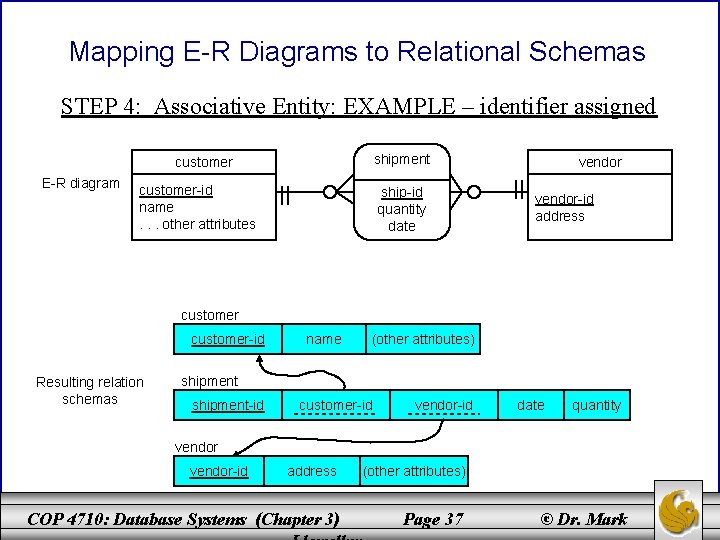
Mapping E-R Diagrams to Relational Schemas STEP 4: Associative Entity: EXAMPLE – identifier assigned shipment customer E-R diagram customer-id name. . . other attributes ship-id quantity date vendor-id address customer-id Resulting relation schemas name (other attributes) shipment-id customer-id vendor-id date quantity vendor-id address (other attributes) COP 4710: Database Systems (Chapter 3) Page 37 © Dr. Mark

Mapping E-R Diagrams to Relational Schemas STEP 5: Mapping Unary (recursive) Relationships • Recall that a recursive relationship is defined as a relationship between instances of a single entity type. • The two most important cases of unary relationships are the 1: M and M: M cardinalities. • We’ll again look at these two cases separately as they are handled somewhat differently. COP 4710: Database Systems (Chapter 3) Page 38 © Dr. Mark
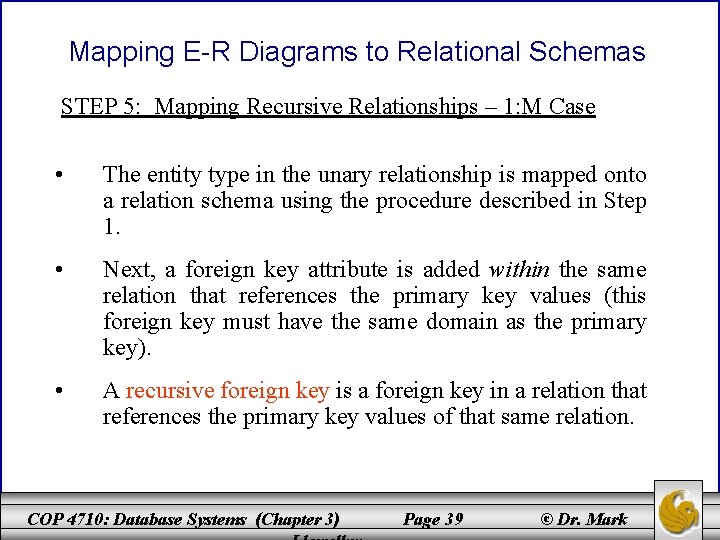
Mapping E-R Diagrams to Relational Schemas STEP 5: Mapping Recursive Relationships – 1: M Case • The entity type in the unary relationship is mapped onto a relation schema using the procedure described in Step 1. • Next, a foreign key attribute is added within the same relation that references the primary key values (this foreign key must have the same domain as the primary key). • A recursive foreign key is a foreign key in a relation that references the primary key values of that same relation. COP 4710: Database Systems (Chapter 3) Page 39 © Dr. Mark

Mapping E-R Diagrams to Relational Schemas STEP 5: Mapping Recursive Relationships: EXAMPLE – 1: M employee every employee has exactly one manager, a given employee may manage many employees E-R diagram employee-id name birthdate foreign key Resulting relation schema employee-id name COP 4710: Database Systems (Chapter 3) birthdate manager-id Page 40 © Dr. Mark

Mapping E-R Diagrams to Relational Schemas STEP 5: Mapping Recursive Relationships – M: N Case • With this type of recursive relationship, two relation schemas are created: one to represent the entity type and the other an associative relation to represent the M: N relationship itself. • The primary key of the associative relation consists of two attributes. These attributes (which do not necessarily have the same name) both take their values from the primary keys of the other relation. • Any non-key attribute of the relationship is included in the associative relation. • The example on the next page illustrates such a case representing a bill of materials relationship among items that are assembled from other items or components. COP 4710: Database Systems (Chapter 3) Page 41 © Dr. Mark
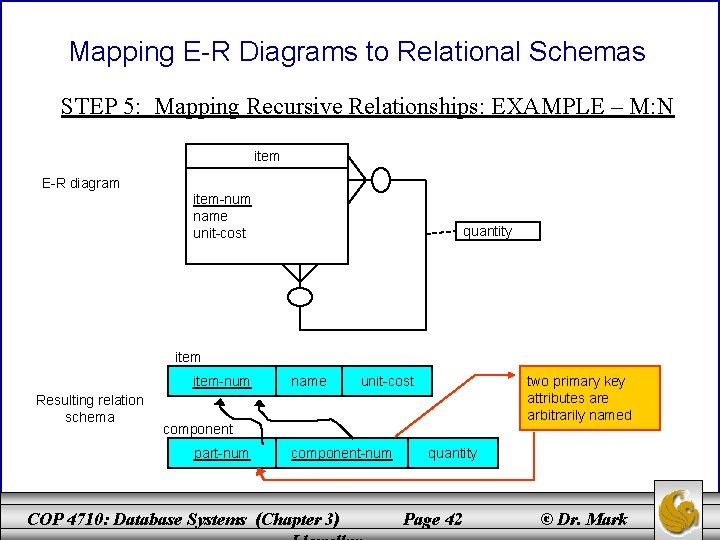
Mapping E-R Diagrams to Relational Schemas STEP 5: Mapping Recursive Relationships: EXAMPLE – M: N item E-R diagram item-num name unit-cost quantity item-num Resulting relation schema name unit-cost two primary key attributes are arbitrarily named component part-num component-num COP 4710: Database Systems (Chapter 3) quantity Page 42 © Dr. Mark

Mapping E-R Diagrams to Relational Schemas STEP 6: Mapping Ternary (and n-ary) Relationships • Recall that a ternary relationship is defined as a relationship among three entity types as shown below. vendors supply various parts to warehouses parts vendors warehouse shipping-mode unit-cost COP 4710: Database Systems (Chapter 3) Page 43 © Dr. Mark
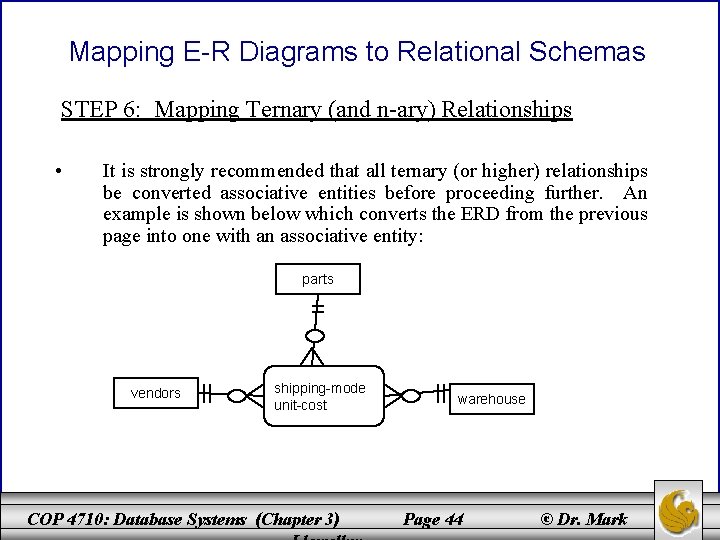
Mapping E-R Diagrams to Relational Schemas STEP 6: Mapping Ternary (and n-ary) Relationships • It is strongly recommended that all ternary (or higher) relationships be converted associative entities before proceeding further. An example is shown below which converts the ERD from the previous page into one with an associative entity: parts vendors shipping-mode unit-cost COP 4710: Database Systems (Chapter 3) warehouse Page 44 © Dr. Mark
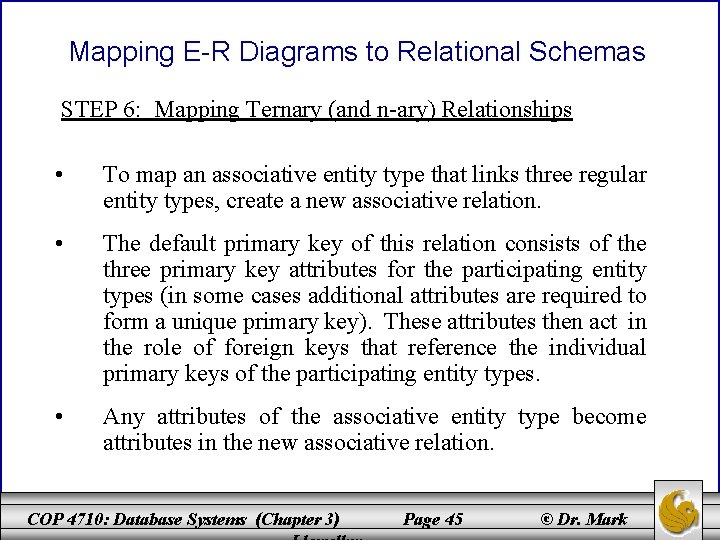
Mapping E-R Diagrams to Relational Schemas STEP 6: Mapping Ternary (and n-ary) Relationships • To map an associative entity type that links three regular entity types, create a new associative relation. • The default primary key of this relation consists of the three primary key attributes for the participating entity types (in some cases additional attributes are required to form a unique primary key). These attributes then act in the role of foreign keys that reference the individual primary keys of the participating entity types. • Any attributes of the associative entity type become attributes in the new associative relation. COP 4710: Database Systems (Chapter 3) Page 45 © Dr. Mark
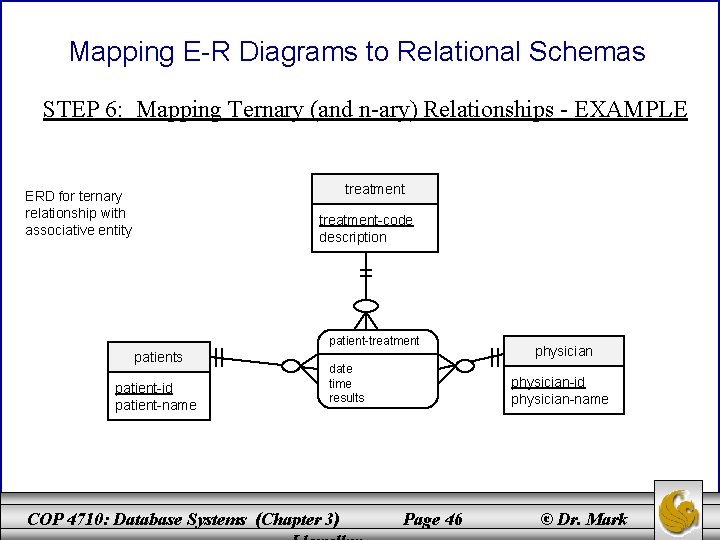
Mapping E-R Diagrams to Relational Schemas STEP 6: Mapping Ternary (and n-ary) Relationships - EXAMPLE treatment ERD for ternary relationship with associative entity treatment-code description patient-treatment patients patient-id patient-name date time results COP 4710: Database Systems (Chapter 3) physician-id physician-name Page 46 © Dr. Mark
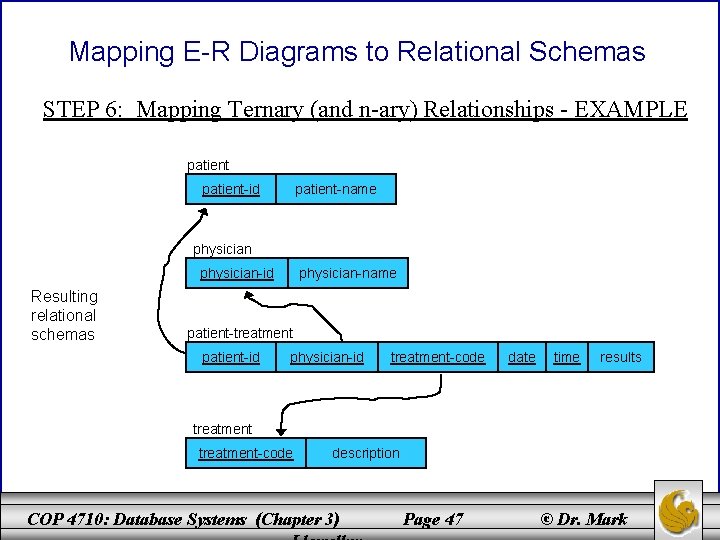
Mapping E-R Diagrams to Relational Schemas STEP 6: Mapping Ternary (and n-ary) Relationships - EXAMPLE patient-id patient-name physician-id Resulting relational schemas physician-name patient-treatment patient-id physician-id treatment-code date time results treatment-code description COP 4710: Database Systems (Chapter 3) Page 47 © Dr. Mark

Mapping E-R Diagrams to Relational Schemas STEP 7: Mapping Supertype/Subtype Relationships • The relational data model does not directly support supertype/subtype relationships. Fortunately, there are various strategies that database designers can use to represent these relationships with the relational data model. • We’ll examine of the more common techniques that has been used for modeling supertype/subtype relationships. COP 4710: Database Systems (Chapter 3) Page 48 © Dr. Mark
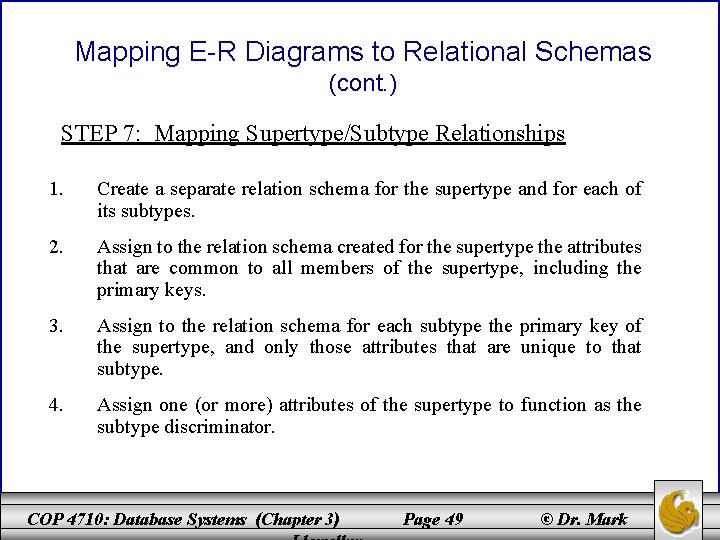
Mapping E-R Diagrams to Relational Schemas (cont. ) STEP 7: Mapping Supertype/Subtype Relationships 1. Create a separate relation schema for the supertype and for each of its subtypes. 2. Assign to the relation schema created for the supertype the attributes that are common to all members of the supertype, including the primary keys. 3. Assign to the relation schema for each subtype the primary key of the supertype, and only those attributes that are unique to that subtype. 4. Assign one (or more) attributes of the supertype to function as the subtype discriminator. COP 4710: Database Systems (Chapter 3) Page 49 © Dr. Mark
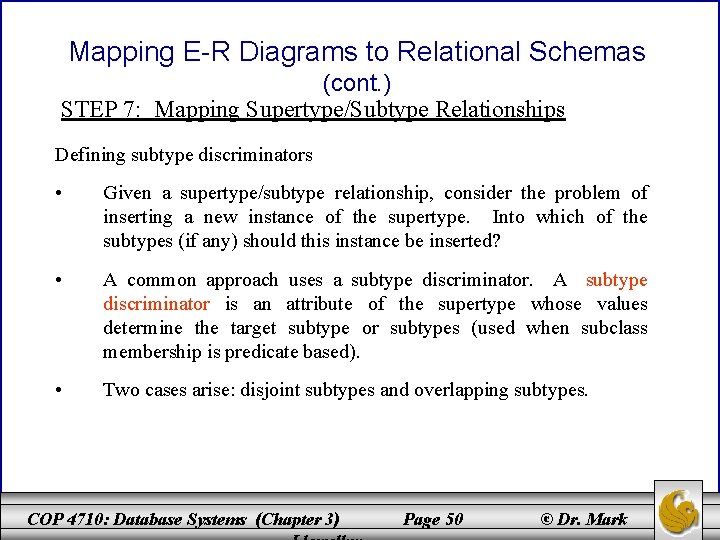
Mapping E-R Diagrams to Relational Schemas (cont. ) STEP 7: Mapping Supertype/Subtype Relationships Defining subtype discriminators • Given a supertype/subtype relationship, consider the problem of inserting a new instance of the supertype. Into which of the subtypes (if any) should this instance be inserted? • A common approach uses a subtype discriminator. A subtype discriminator is an attribute of the supertype whose values determine the target subtype or subtypes (used when subclass membership is predicate based). • Two cases arise: disjoint subtypes and overlapping subtypes. COP 4710: Database Systems (Chapter 3) Page 50 © Dr. Mark
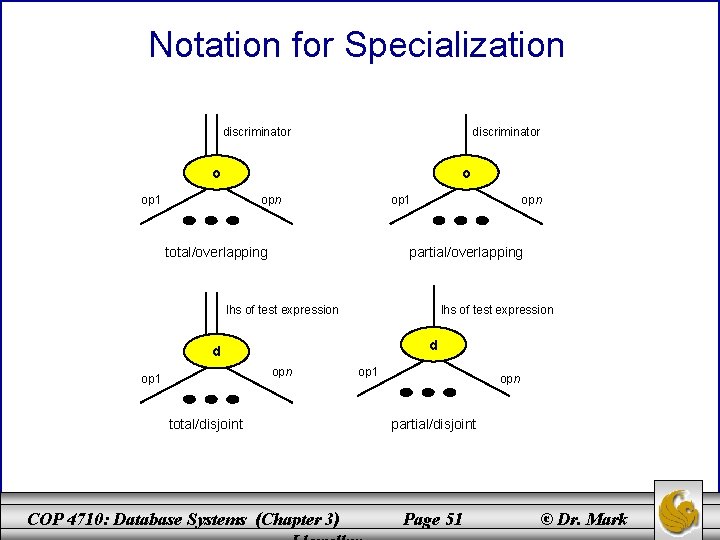
Notation for Specialization discriminator o o op 1 opn op 1 total/overlapping opn partial/overlapping lhs of test expression d d opn op 1 total/disjoint COP 4710: Database Systems (Chapter 3) op 1 opn partial/disjoint Page 51 © Dr. Mark
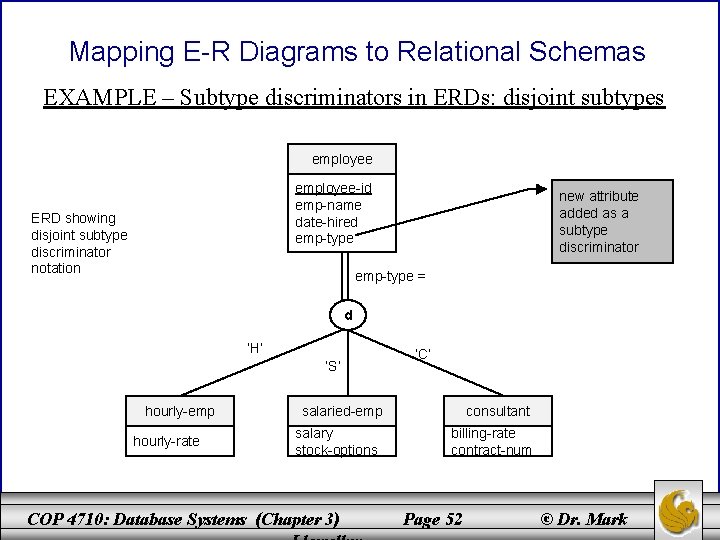
Mapping E-R Diagrams to Relational Schemas EXAMPLE – Subtype discriminators in ERDs: disjoint subtypes employee-id emp-name date-hired emp-type ERD showing disjoint subtype discriminator notation new attribute added as a subtype discriminator emp-type = d ‘H’ ‘S’ hourly-emp hourly-rate ‘C’ salaried-emp salary stock-options COP 4710: Database Systems (Chapter 3) consultant billing-rate contract-num Page 52 © Dr. Mark
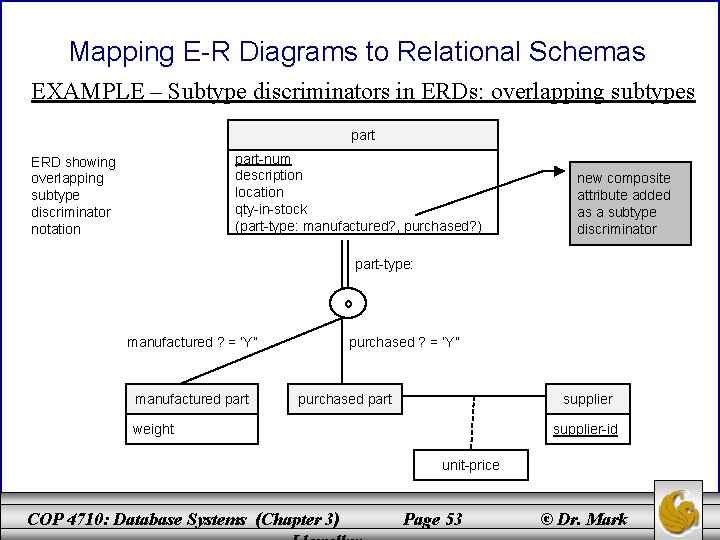
Mapping E-R Diagrams to Relational Schemas EXAMPLE – Subtype discriminators in ERDs: overlapping subtypes part-num description location qty-in-stock (part-type: manufactured? , purchased? ) ERD showing overlapping subtype discriminator notation new composite attribute added as a subtype discriminator part-type: o manufactured ? = ‘Y” manufactured part purchased ? = ‘Y” purchased part supplier weight supplier-id unit-price COP 4710: Database Systems (Chapter 3) Page 53 © Dr. Mark
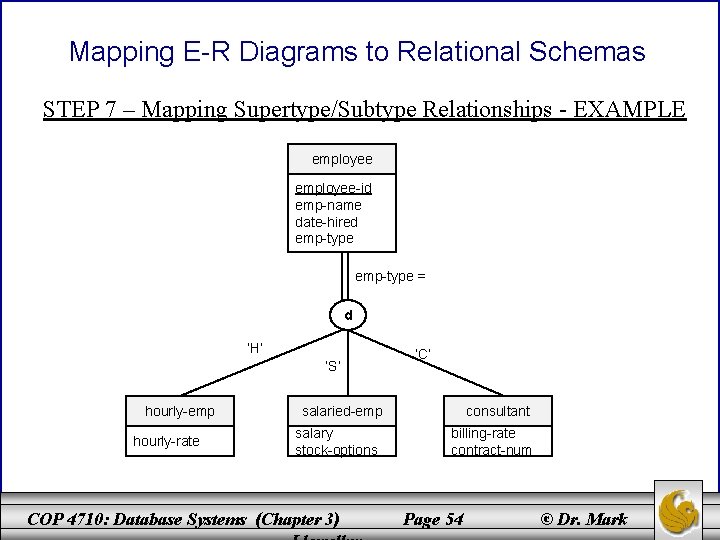
Mapping E-R Diagrams to Relational Schemas STEP 7 – Mapping Supertype/Subtype Relationships - EXAMPLE employee-id emp-name date-hired emp-type = d ‘H’ ‘S’ hourly-emp hourly-rate ‘C’ salaried-emp salary stock-options COP 4710: Database Systems (Chapter 3) consultant billing-rate contract-num Page 54 © Dr. Mark

Mapping E-R Diagrams to Relational Schemas STEP 7: Mapping Supertype/Subtype Relationships - EXAMPLE employee-id emp-name address emp-type date-hired hourly emp h-employee-id Resulting relational schemas hr-rate salaried-emp s-employee-id salary stock-opt consultant c-employee-id contract-num COP 4710: Database Systems (Chapter 3) billing-rate Page 55 © Dr. Mark
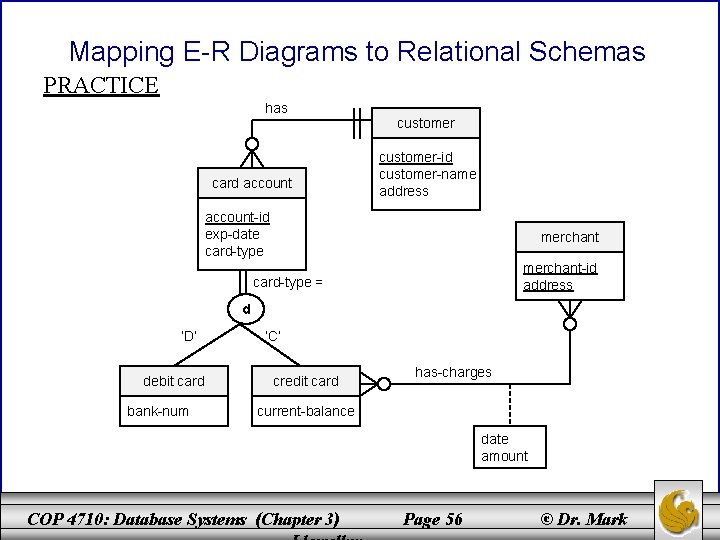
Mapping E-R Diagrams to Relational Schemas PRACTICE has card account customer-id customer-name address account-id exp-date card-type merchant-id address card-type = d ‘D’ debit card bank-num ‘C’ credit card has-charges current-balance date amount COP 4710: Database Systems (Chapter 3) Page 56 © Dr. Mark

Mapping E-R Diagrams to Relational Schemas SOLUTION to practice problem customer-id customer-name customer-address card account-id expr-date acct-type debit card d-acct-id customer-id credit card bank-num c-acct-id current-balance charges c-acct-id merchant-id date amount merchants merchant-id merchant-address COP 4710: Database Systems (Chapter 3) Page 57 © Dr. Mark
- Slides: 57
